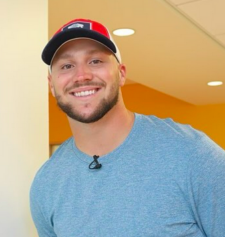By Lydia Beyoud
Gary Gensler has positioned himself as one of the most consequential policymakers in American finance. He didn’t start off as a regulator. The Baltimore native and self-described “markets person” spent 18 years at Goldman Sachs Group Inc., where he became a partner at 30 and led divisions including fixed income and currency trading in Asia. Gensler left to serve in senior roles in the US Department of the Treasury under President Bill Clinton, where he helped to pass a law that kept over-the-counter derivatives unregulated.

But in 2001, in the wake of corporate frauds such as those at WorldCom and Enron, Gensler went to work for Maryland Senator Paul Sarbanes on drafting the Sarbanes-Oxley Act to improve public-company accounting and disclosure. And after the 2008 financial crisis, he was nominated by President Barack Obama to reform the $400 trillion swaps market as chair of the Commodity Futures Trading Commission—regulating the very market he’d once helped keep free of regulation. Industry executives who negotiated with him at the time have described him as a formidable opponent and a deft Washington operative.
Now, in his less than two years as chair of the US Securities and Exchange Commission, Gensler has already set about making rules that would affect broker-dealers, retail traders, digital assets, private funds, corporate boards and the very plumbing of the Treasury and equities markets.
Gensler, 65, met with Bloomberg Markets in late October in a room atop the SEC’s Washington headquarters with a view of the Capitol to talk about how he plans to summit the mountain of regulatory action he’s built for himself. (He later responded to an additional question about the implosion of cryptocurrency exchange FTX.) This interview was edited for clarity and length.
LYDIA BEYOUD: Competition seems to be at the center of your agenda. Is that how you would describe it?
GARY GENSLER: I’ve thought of finance as sitting at the middle of an hourglass. The two sides of the hourglass widen out, and there’s a lot of sand—the sand is money and risk—and all finance at that center is the pricing and allocation of money and risk. It’s about the middle of the markets. It’s said that we have a three-part mission: investors on one side, issuers on another and that which is in the middle—the markets. A lot of what I focus on every day is how we can drive for greater efficiency and competition in the middle. That lowers the cost for investors; therefore investors also get better returns. And I think it lowers the cost for issuers on the other side, the people that are raising money to have their great ideas have a chance for success.
LB: What are the regulatory gaps you’re addressing?
GG: Technology is so rapidly advancing. We’ve had, of course, the full digitalization of financial assets—and I’m not talking about cryptocurrencies. I’m talking about Treasury bonds, regular equity securities—it’s all digital, and it’s trading very quickly. Communications costs in the last several decades have come dramatically down, and we’re interconnected across the globe.
We’re in a significant transformational time around predictive data analytics and the use of data, artificial intelligence and machine learning. And we haven’t updated many of our core rules around market structure, whether it’s the US Treasury market, which is a $24 trillion to $25 trillion market. Or even a very quickly growing area, private funds, which in total—hedge funds, private equity—add up to about $21 trillion as of the end of last year. That’s about to surpass the size of our entire commercial banking sector, which is just $23 trillion. So, recognizing the rapid change of technology, [we’re] updating our basic rules of the road within the authorities Congress has given us and how the courts interpret them for the betterment of the American public.
LB: Are you saying the changes in technology are creating regulatory gaps you need to address, or do you want to somehow bolster securities regulation for the future?
GG: The nature of finance since antiquity tends toward centralization and concentration, because of the economic benefits of scale, of networks. And yes, the economic benefits of data tend toward centralization. And that was true of the Medicis in the 15th century. It was true of the person J.P. Morgan. It is even true now in crypto— you see centralization. So No. 1 is just how to do what Congress told us to do in our statutes: They made us a competition-focused agency in 1975, and in 1996 they amended our laws to say we had to focus on competition and efficiency.
So [we’re] looking at how to use the tools of transparency and access and fair dealing and the like to effectuate that, to lower the cost in the middle. Two, I do think technology leads to gaps. One area, for instance, [is] robo-advising—an algorithm making decisions and recommendations, steering a customer one way or the other based upon data sourced from many inputs, including possibly our Fitbits, the telematics on our automobile and how we drive, our social media footprints. You have natural gaps and potentially inherent conflicts. What does it mean when an investment adviser has a fiduciary duty to put their customer’s interest in front of their own, but the algorithms and the data that they’re sourcing might steer them [to prioritize] the robo-adviser’s revenue rather than your well-being? So competition gaps as well. And I’d say thirdly, business models change. Nothing stands still.
LB: You mentioned that part of your goal is to make markets fair for the public. But we have a whole generation of Americans who are losing trust in the financial markets. There are millions of Americans who are struggling to buy food or medicine, much less save for retirement or participate in financial markets in a meaningful way. What concrete steps can the SEC take to both restore trust and support participation in the market?
GG: This is a really consequential and remarkable agency, but our remit is just overseeing the $100 trillion capital markets. I know that sounds big, but it’s about protecting those investors and facilitating issuers raising money in the middle of the markets. We’re not a merit regulator.
But in terms of trust—I do think that trust is at the base of financial systems, and those that work better for societies throughout history tend to have certain tenets to instill greater trust. And those that break down tend to have less. Transparency is really important. Disclosure and transparency versus darkness or opacity. If you want to raise money from the public, you have to have full, fair and truthful disclosure of all the material information and the financials and the like. We’re doing that in our agenda right now—to try to address it through leveling the playing field in our stock market between what’s called the dark markets and the lit markets. On any given day between a third and a half of equity trading in the US is going to the dark markets. So disclosure and transparency are really important, but it’s also about market integrity—guarding against fraud, manipulation—and fair dealing.
I think it’s also about access. Not just access to the markets but access to information. Whether you’re buying 10 shares of stock or 10,000, whether you’re just starting out saving for your next holiday or you’re a CEO of a big company, [it’s important] that the same rules apply to you and that there’s kind of a fair deal across the markets and a level playing field and market integrity. Those are the things that we can focus on here. And then, of course, being a cop on the beat. Read More: Wall Street Whistleblowers Tip Off SEC — But Hear Nothing Back
LB: A lot of your proposals would increase the amount of information market participants have to provide. I think the climate disclosures proposal for stock issuers is the most prominent of those. An SEC Office of the Inspector General report highlighted some concerns by senior managers that the pace of your agenda is perhaps exceeding the resources you have to accomplish it. The report said that raises some litigation risk. What do you think of the issues raised in that report, and how are you going to try and bolster these different rule makings for the coming legal challenges they’re going to face?
GG: The agency had shrunk during the previous administration by about 5%, in a time that we should have grown at least that much. We are about 4,500 people, half of whom are in examinations and enforcement. The staff covers probably somewhere on the order of 50,000 to 100,000 critical filings and decisions around those filings a year, whether those are companies going public, or new mutual funds or exchanges doing rule filings. We as a commission actually vote on a thousand items a year. I share this with you to say there’s a lot this remarkable staff and agency works on.
In terms of your second point about how are we going to move forward, we put out to the public a list of our agenda [items] similar in many ways—in length—to predecessors. We have about 50 or 55 items on that. My immediate predecessor finalized 64 rules while he was in for his four years.
LB: That’s true, but the report noted that you proposed about 26 rules, a little over half of your agenda, in the first eight months of 2022. Are you trying to get as many proposals as possible out before January?
GG: The privilege of [government] service is not one to be taken lightly, and it’s finite. So to work with the staff and get thoughts down on paper, to get to a term sheet, to get from a term sheet to discuss it with five commissioners and to get to a proposal and put it out to the public, I think is really an important thing to do. I’m one of five children, and I’m an identical twin, and I was a partner of a firm on Wall Street that actually believed in a partnership form—that we all rose or sunk together. I really do believe in this team orientation. So if we were successful getting proposals out a little earlier than my predecessors, that might be just bringing some of this team orientation and trying to problem solve early and get the proposals out.
LB: I’d be remiss if I didn’t ask you one crypto question.
GG: What took you so long? Can I say something, Lydia?
LB: Go ahead.
GG: We have a market: bonds, stocks, other securities—$100 trillion. The worldwide crypto market: about $1 trillion. If you look at the stock market alone in the US and you see how many companies have a market value greater than the leading cryptocurrency Bitcoin, it’s about 30. I’m just trying to put it in [the perspective of] size and scale, that most of what this agency focuses on is not in this new technology. But, to your question.
LB: What are your thoughts about next steps for the crypto industry in light of FTX’s collapse and the destabilizing effect that’s having on other digital asset platforms? How can the government best help those who are being impacted by these events, or who are investing in crypto?GG: While I can’t speak to any individual entity, the best way for crypto investors to get the protections they deserve is for intermediaries such as crypto trading and lending platforms to come into compliance with the law and register with the SEC. Investors have benefitted from nearly 90 years of well-crafted protections that provide investors the disclosure they need and that guard against misconduct like misappropriation of customer assets, fraud, manipulation, front-running, wash sales, and other conflicts of interest that harm investors and market integrity. Nothing about the crypto markets is incompatible with the securities laws.
LB: There are researchers looking into quantum computing, and they’ve said it could break blockchain technology within the next 10 years or so. Is quantum computing an existential threat to digital assets, and what does that mean for regulators like yourself?
GG: Oh, so you want to take me back to my MIT days? Satoshi Nakamoto’s innovation—whoever she, he or they were, I’ll say she—Satoshi’s white paper was published 14 years ago, and that was the Bitcoin white paper. It has an accounting ledger, and it’s storing that information on what you call a blockchain: 10,000 or so computers around the globe. Nakamoto addressed this question—if the underlying ledger could be cracked through quantum computing, which is almost bound to happen. Cryptography is about math at some level. And even with one-way math formulas you can use some brute force and reverse them and crack them. I don’t know if her observations will prove out, but it was interesting that it was envisioned even at that point in time as to part of the reason why it’s in the technology, why she had double-hash functions and things like that.
Having said that, to the regulatory side, what we’re focused on, whether it’s about quantum computing or not, whether a blockchain technology will persist or not, is investor protection. There are about 10,000 tokens at the time of this interview. And the investing public is investing in these tokens. That’s where the SEC has a role. It’s about full, fair and truthful disclosures. It’s ensuring that the intermediaries aren’t defrauding or manipulating or misleading the public. It’s for those asset managers to have the fiduciary duties that I talked about earlier. It’s all the same public policy. It just happens to be a new technology about how to store an accounting ledger called blockchain.
LB: The Fifth Circuit ruled [on Oct. 19] that the Consumer Financial Protection Bureau’s funding structure is unconstitutional. There seems to be growing skepticism about the administrative state in our court system generally. A lot of industry groups are practically lining up to litigate whichever aspects of your rules they dislike once they’re finalized. You are building a legacy here through some very significant regulatory changes. What happens if someone challenges a rule but the outcome from court ends up knocking down some of this agency’s powers? How do you think about all that?
GG: I’m going to share a little story from my early days at the Commodity Futures Trading Commission. It was 2010, late spring, and the House and Senate were conferencing what became Dodd-Frank. We had, in anticipation of the president signing a bill, started to put together a process of how to move forward on what would’ve been 60-plus required rule makings. And Congress actually, in the draft at that time, had a one-year deadline we had to do all of it in. We got in a room downstairs at the CFTC, the hearing room, and the 30 to 40 team leads, we spent two hours together talking about how we might move forward. And one of the pieces was on the question you’re just raising, the Administrative Procedure Act, and how to ensure that that which we did had resilience. And I shared a story with the group of 40 or 50 people: I have an identical twin brother, Rob. He’s never served in government. He was a research analyst at T. Rowe Price and then later a portfolio manager. He covered the telecom field in the 1990s. He said, “Gary, just don’t let happen to you what happened to the Federal Communications Commission from the 1990s, when they put some rules in place and they all got overturned.”
The point of this story is I had this echoing in my mind and I shared it with the people in the room. And I just said, “That [outcome] doesn’t help the American public. We had a crisis of major proportion, and part of it was the swaps market. Congress is about to give this agency a large grant of additional authority to lower the risk and add transparency to that market. Let’s do it so that it’s within the law, within the economics, and it’s sustainable.”
It’s a different agency, different times. But at that point we did 67 Dodd-Frank actions, and we did another 15 or 16 not related—so 80-plus. We got challenged in court. That’s part of democracy, that’s part of our constitutional system. We only lost one. And we got challenged on way more than one.
LB: Sounds like you’re feeling good about your odds.
GG: Congress set up this agency nine decades ago. They’ve multiple times changed and amended the laws. There are always uncertainties. But those authorities about protecting the public—whether it’s in what we do in equity market or Treasury market structure—I really do believe that it’s important for us to follow the authorities Congress has granted us and stay within those. And I think that any time the Supreme Court speaks it’s significant, and we look at it and we do our best to stay within those parameters.
LB: I read that you enjoy mountain climbing. What do you enjoy about it?
GG: I love the mixture of the beauty, the serenity, the physical challenge. I feel so infused with life waking up in the frigid cold on Mount Rainier next to my daughter on summit day. Waking up at 12:30 a.m., getting those boots on and getting all the gear on and even getting out of the tent. Mount Rainier isn’t that high—fourteen, fifteen thousand feet—but it’s a nice little summit. It’s just joyful.
I learned about athleticism from Ted Nash, an Olympic athlete. He was coach of the University of Pennsylvania crew, and I showed up looking to become part of a sailing team in the spring of 1975. And he said, “Sailing? We’ve got crew.” I learned about team sports because [in] crew if any one person gets that blade in or out of the water just a little off or if their seat slide is off, you’re going to lose that race. I took up running and biking then, and I’ve loved it ever since. I’m slow and steady. I don’t want anybody to think that I’m a marathoner or a century bike rider or a mountain climber, but slow and steady. I learned that prep matters. Clearly, know what your goals are: summit, you know, or a 100-mile bike ride or the end of the marathon. But have a strategy on how to get there and do a bunch of prep.
Beyoud covers financial regulation for Bloomberg News in Washington.
More stories like this are available on bloomberg.com




